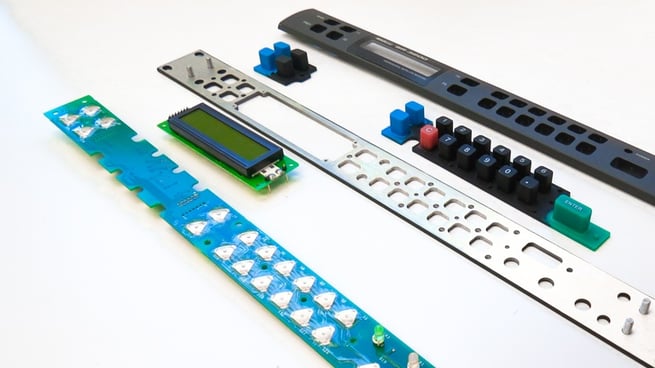Manufacturing complete human-machine interface (HMI) assemblies can be a complex and difficult journey, which is especially true if it involves more than one supplier. This blog post mentions a few of the great advantages of being able to work with a single full service HMI supplier.
1. All Under One Roof
Working with a single entity that receives the entire scope of work, and all of the requirement documents makes it a lot easier to capture all of the application requirements in a single HMI design.
This also creates a level of accountability for one company and design team so that the customer doesn’t need to play referee during the initial start-up phase when there are always scope changes and functionality that weren’t accounted for.
With more than one company involved it is easy to forget who was told what and if all of the requirements were passed on to all affected parties.

Various Components of a User Interface Assembly
2. Rapid Speed
Requiring the ability to rapidly change your HMI design and update all BOM components on the fly is common when developing custom user interface assemblies. If the location of a dome switch needs to move, this will impact the overlay, membrane switch, and possibly the flex tail exit location.
This can be better managed and done faster by a full-service HMI supplier, instead of having to contact two or more suppliers when a design change occurs.
3. Troubleshooting and Debugging
It’s easy to simply blame another supplier for the root cause of a product failure. The full-service HMI supplier that owns the entire scope of work can better analyze, troubleshoot, and fix an issue if they own the design.
For example, this minimizes risk during the integration phase of serial interface connections, when only working with one supplier has the ability to design and test serial communication bus real-time.
4. Schedule Recovery
A one-stop-shop style HMI supplier owns their own destiny and can develop and execute a recovery plan vs being paced by another vendor on an item on the critical path.
5. Lower Risk
One PO, one P/N, one vendor, one shipping transaction = less risk.
Faster time to market is an important factor in many cases for OEMs. A lot of the pieces on a SMART HMI are delicately integrated into one another. Using one company to manufacture the entire assembly allows all of the components to be in design at the same time as the teams are working together to ensure that all changes are quickly integrated through the design.
This also reduces costs as if you have a mechanical, electrical, and software developers that are different and charging by the hour, every change creates additional expense.
6. Engineering Solutions
If a customer wants a change to be made, a company that is doing the project can focus on the best solution for the customer and not the solution that creates more billable hours.
Want to add more functionality? The mechanical designer wants to add another button and LEDs which increases his scope while the software team wants to develop more graphics and logic to solve the problem.
Which one is better? With a full-service supplier, the best and most cost-effective solution will quickly surface.
7. Reduction In Production Cost
Most SMART HMIs can have over twenty different functional layers in a design, which would mean having to manage documentation, receive in, inspect, assemble, program, and test that many different items.
Customers can have one final assembly to inspect by using a document storage program like Box, they will also have instant access to the most up to date drawings instantly.
Summary
Manufacturing a complete human-machine interface (HMI) assembly can be complex, particularly when multiple suppliers are involved. Each component, mechanical, electrical, and software, must work together seamlessly, and dividing responsibilities among several vendors often leads to communication breakdowns, delays, and cost overruns.
Partnering with a single full-service HMI supplier simplifies the process by consolidating design, engineering, and production under one roof. This approach ensures faster design iterations, improved accountability, reduced risk, and more efficient troubleshooting, all while keeping overall costs and timelines under control.
Key Takeaways
- Centralized Accountability Enhances Efficiency: A single full-service HMI supplier manages all design and production elements, preventing communication gaps and ensuring full ownership of project success.
- Faster Design Revisions and Updates: With one team controlling every stage, design modifications like dome switch adjustments or flex tail changes can be implemented quickly without coordinating across multiple vendors.
- Simplified Troubleshooting and Integration: When one supplier owns both hardware and software design, diagnosing and resolving issues—such as serial communication errors—becomes faster and more accurate.
- Reduced Risk and Cost: Managing a single purchase order, part number, and shipment minimizes administrative overhead, accelerates time to market, and prevents cost creep from hourly design changes across separate teams.
- Streamlined Engineering and Production: Consolidating the entire build, from concept through testing, allows teams to collaborate in real time, ensuring the most functional, cost-effective, and manufacturable HMI design.
















